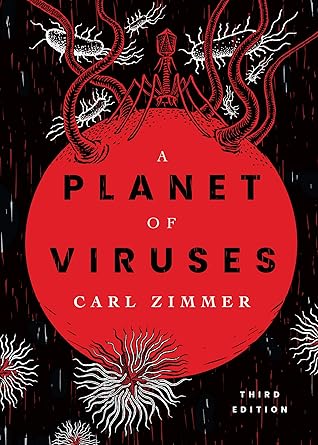More on this book
Community
Kindle Notes & Highlights
Willner discovered that, on average, people have 174 species of viruses in their lungs. Only 10 percent of the species Willner found bore any close kinship to any virus ever found before. The other 90 percent were as strange as anything lurking in the Cave of Crystals.
Virologists discovered that viruses can replicate themselves, despite their paltry genetic instructions, by hijacking other forms of life. They inject their genes and proteins into a host cell, which they manipulate into producing new copies of themselves. One virus goes into a cell, and within a day thousands of viruses may come out.
viruses help produce much of the oxygen we breathe and help control the planet’s thermostat. And they certainly would not have guessed that the human genome is partly composed from thousands of viruses that infected our distant ancestors, or that life as we know it may have gotten its start four billion years ago from viruses.
Infected cells release signaling molecules, called
cytokines, which attract nearby immune cells. Those immune cells then make us feel awful. They create inflammation that triggers a scratchy feeling in the throat and leads to the production of mucus around the site of the infection.
human rhinoviruses may offer some benefits to their human hosts. Scientists have gathered a great deal of evidence that children who get sick with relatively harmless viruses and bacteria may be protected from immune disorders when they get older, such as allergies and Crohn’s disease. Human rhinoviruses may help train our immune systems not to overreact to minor triggers, instead directing their assaults to real threats.
Speeding up a cell’s division is no small feat, especially for a virus with just eight genes. It has to take over a series of biochemical reactions that are marvelously complex.
While the cervix is the most common tissue where HPV causes cancer, it’s not the only one: it can also create tumors in the vagina, the penis, and the back of the throat.
In total, scientists estimate, viruses cause 11 percent of all cancer cases—all potentially preventable by vaccines.
this endogenous retrovirus infected the common ancestor of all mammals with placentas, which lived over 100 million years ago. Today, that virus lingers on, in armadillos and elephants and manatees. And in us.
Each of us carries almost 100,000 fragments of endogenous retrovirus DNA in our genome, making up about 8 percent of our DNA.
The cells in the outer layer of the placenta made syncytin in order to join together, so that molecules could flow between them.
HIV is a retrovirus, which means that it inserts its genetic material into the cell’s DNA. From there, it manipulates the cell to make new viruses that can escape to infect other CD4 T cells.
the fourth—which originated in chimpanzees that live in Cameroon—produced a lineage of viruses called HIV-1 Group M that today accounts for 90 percent of all HIV-1 infections. (M is short for main.)
China around the year 900. Physicians would rub a scab from a smallpox victim into a scratch in the skin of a healthy person. (Sometimes they administered it as an inhaled powder instead.) Variolation, as this process came to be called, typically caused just a single pustule to form on the inoculated arm. Once the pustule scabbed over, a variolated person became immune to smallpox.
smallpox infects only humans, not animals. If it could be systematically eliminated from every human population, there would be no need to worry that it was lurking in pigs or ducks, waiting to strike again.
few genes that viruses carried allowed them to execute the barest tasks required for making new viruses: to invade a cell and slip their genes into a cell’s biochemical factories.
Viruses, on the other hand, have no repair enzymes. As a result, they make copying errors at a tremendously higher rate than we do—in some cases, over a 1,000 times higher.
to think about how viruses and other organisms form a continuum. We humans are an inextricable blend of mammal and virus. Remove our virus-derived genes, and we would die in the womb. It’s also likely that we depend on our viral DNA to defend against infections. Some of the oxygen we breathe is produced through a mingling of viruses and bacteria in the oceans. That mixture is not a fixed combination, but an ever-changing flux. The oceans are a living matrix of genes, shuttling among hosts and viruses.
Patrick Forterre, a French virologist, has proposed that in the RNA world, viruses invented the double-stranded DNA molecule as a way to protect their genes from attack. Eventually their hosts took over their DNA, which then took over the world.


